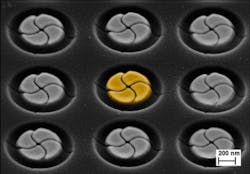Princeton Instruments, which makes low-light imaging and spectroscopic instruments, has highlighted the recent work of Saulius Juodkazis, professor of nanophotonics at Swinburne University of Technology (Swinburne, Australia), and his team. The Swinburne group was able to image a line of chiral nanoparticles in array and detect an extinction spectrum without distortions, aided by the sharp focus and astigmatism compensation of the Princeton Instruments IsoPlane spectrometer, says the company. The project is part of the Melbourne Center for Nanofabrication (MCN), the largest nanotechnology facility in the southern hemisphere.
Recent advances in high-precision nanofabrication of 10–100 nm features on micro- and nanoparticles by electron-beam lithography (EBL) and focused ion-beam (FIB) milling create challenges for measuring the optical properties of such nano-objects. High-fidelity fabrication of arrays of nanoparticles with nanofeatures inscribed by FIB has been demonstrated.1 Such arrays of uniform particles are required for sensitive detection of absorption and light scattering at low concentrations of analyte (in gas/air or solution) by surface-enhanced Raman scattering (SERS). Arrays of nanoparticles can also be used to trap molecules and nano-objects at high-intensity-light locations ("hot spots") on the nanoparticles.2
Optical characterization of individual particles, as well as of arrays, via imaging (dark and brightfield microscopy) and spectral-extinction measurements provide the first and most informative evaluation of the fabricated patterns and individual nanoparticles. The IsoPlane spectrometer with an imaging microscope was used to obtain results published in references [1, 2].
For more information, see http://nanomelbourne.com/saulius-juodkazis and http://www.princetoninstruments.com/products/spec/isoplane/
REFERENCES:
1. G. Gervinskas, G. Seniutinas, L. Rosa, and S. Juodkazis, “Arrays of arbitrarily shaped nanoparticles: overlay-errorless direct ion write,” Adv. Optical Mater. 1(6), 456–459, 2013.
2. G. Seniutinas, L. Rosa, G. Gervinskas, E. Brasselet, and S. Juodkazis, “3D nano-structures for laser nano-manipulation,” Beilstein J. Nanotechnol. 4, 534–541, 2013.

